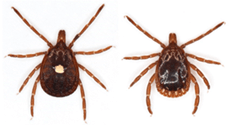Justin Talley PhD; Dept. Head OSU Department of Entomology and Plant Pathology
Tick activity in Oklahoma has been increasing in recent months. One tick that is gaining more press is the Lone Star tick, Amblyomma americanum, (Fig. 1) due to the condition that can result in some individuals having an allergic reaction to the consumption of red meat. This condition is known as Alpha gal syndrome or more commonly known as “Red Meat Allergy” caused by tick bites. Alpha-gal is a sugar compound that is present in the tick’s saliva and when feeding on a person they transmit this compound into the bite site. When this occurs then in some people this will trigger an allergic reaction to red meat including beef, pork, or lamb.
The severity of the reaction will vary among different people with some having a delayed reaction up to 4-6 hours after the consumption of meat. Common symptoms seen in individuals having a reaction to red meat are scaly skin, swelling of body parts including the lips, tongue and throat, shortness of breath, headaches, digestive issues, runny nose, and sneezing. Most medical professionals believe this allergic reaction is severely under-reported due to the delay in the allergic reaction. Individuals should seek medical advice from an allergist if you experience or suspect to be encountering an allergic reaction especially if you know you have had tik bites in the past. More severe reactions that cause anaphylaxis (restriction of breathing), full body redness (flushing), rapid or weak pulse, dizziness, and an inability to swallow should seek medical attention immediately.
Specifically, when a Lone Star Tick feeds on animals such as beef, they pick up the alpha-gal molecules then transmit those to a human when feeding. All animals that represent red meat has various levels of alpha-gal molecules present in the tissue. Every individual person is different in immune response and little is understood to factors that increase the risk of this reaction. One pattern especially for ranchers, is that individuals that are exposed to many tick bites from the Lone Star Ticks over time then can develop severe symptoms. These severe reactions can lead to never being able to consume any red meat due to how the immune response functions in relation to activating when alpha-gal molecules are introduced in the body.
There is evidence that other tick species are involved but in Oklahoma the most common tick feeding on cattle and humans during the summer is the Lone Star Tick. There are methods from developing red meat allergies and the main thing to lower the risk is to prevent ticks from attaching or not attaching for a long period. The following precautions should be taken by those outdoors:
- Use repellents when outdoors especially in known tick areas
- Wear light colored clothing in order to see ticks crawling on you
- Cover up with long sleeves or pants when in a heavily infested tick area
- Conduct a tick check immediately after coming in from the outdoors
- Take a shower as you as you come indoors mainly due to ticks will crawl over the skin sometimes for hours before attaching
- If a tick is found, then remove it with tweezers
The concerning issue is that there is no predictability on who will actually develop an allergic reaction to red meat after a bite from the Lone Star Tick. There is increasing evidence that more people are being diagnosed with this allergy. From the perspective of livestock producers, you not only have to protect yourself but try to limit the amount of Lone Star Ticks feeding on their animals to limit those ticks from transferring the alpha-gal compound. This is very challenging since tick populations are associated with the pasture environment not necessarily what you put on the animals to treat for ticks. Pastures that have a combination of tall grass, open grass areas neighboring wooded areas, and high wildlife activity are more prone to have higher tick populations. Burning pastures can limit tick populations for a period but then after normal forage and wildlife / livestock activity resumes then the tick populations will increase with some pastures supporting very high tick populations. Another issue for the Great Plains region is that pastures with high densities of Eastern Red Cedar trees support high Lone Star Tick populations. Ideally, livestock producers need to try to limit cedar growth in their pastures and implement some type of burning program to prevent large populations of ticks. If burning is not an option, then limit access to pastures with historic tick problems. Also, remember tick populations are difficult to measure because most tick infestations are not detecting until those animals are being looked at in a chute.
Overall, livestock producers can play a role in limiting tick populations that are feeding on their animals by identifying pastures with known tick problems then taking the appropriate steps to provide some level of protection for those animals with insecticides or dewormers. If livestock producers can limit the amount of ticks feeding on their animals then it could potentially limit the number of ticks transmitting the alpha-gal molecules to human populations.

Dr. Justin Talley, OSU Entomology and Plant Pathology department head and Extension livestock entomologist, explains the connection between Lone Star Ticks and red meat allergies on SunUp TV.
